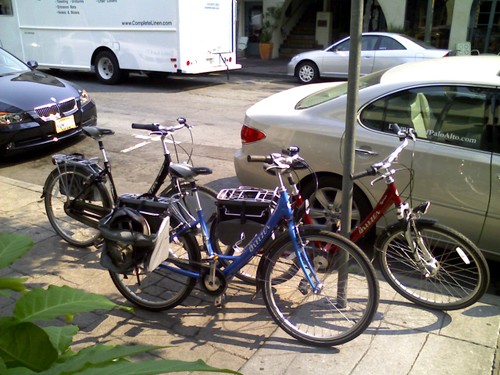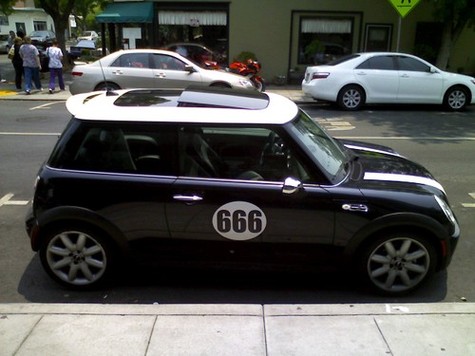"Courage is being scared to death and saddling up anyway."
– John Wayne
Author Archives: Diego Rodriguez
Push and Pull marketing
Reilly Brennan has a great post over at his blog about the need for better "push" marketing tools: Nobody has figured out push media on the internet yet
Here’s an excerpt:
… push’s shortcomings in the internet era have driven us to
a lot of pull. People have just become omnivorous pullers—a day spent
checking bookmarks across dozens of websites. Of course, that’s not all
bad. Pull can be fun—we want to hunt when we want it. Plus, I don’t
really want a potato salad subscription—I just wanted one recipe.
When he’s not thinking critically about the future of marketing, the multi-talented Mr. Brennan gets to test drive sweet rides like the new Corvette ZR1. Which definitely qualifies as a "push" car.
@ Deep Glamour
Little did I realize upon starting this humble blog several years ago that it would be a ticket to some strange and wonderful trips. For instance, over the past year this blog has introduced me to many of the folks behind the magazines (this was pre-web browser historical timeframes) that taught me about the worlds of cars, engineering, aesthetics, design and marketing. These new friendships have been very meaningful to me.
And now I’m writing about glamour. Deep Glamour, that is. If you’ve ever met me in person, you know that I’m not quite a full-blown sartorialist (though I’d like to be). So thinking about what glamour is and what it does is a nice challenge from a personal growth standpoint, and an exciting one. Deep Glamour looks like it will be a fun and interesting blog about all the things that orbit this fuzzy but oh so compelling notion of glamour. I hope to post something every week or so as long as the management will have me.
Part of being innovative and creative is finding safe ways to take a first step. So, faced with an unknown domain, I wrote about cars, which is a cozy domain for me.
My intent in writing metacool was to have a personal sandbox for playing with ideas, so there you go. Please check out Deep Glamour — I’ve been a huge fan of Virginia Postrel for many years, and in fact her writing was a significant point of inspiration behind my return the mainstream of design thinking a few years ago. As you’ll see on the blog, her thinking is deep and will make you think and think and think.
Marketing, sneezers, Breezers, and the Big Sort
I snapped this photo of three Breezer bikes outside a Palo Alto cafe. Three women rode up separately and then sat together for a chat and some coffee. This photo says everything about the state of marketing and product design today. That is, marketing = design = marketing. You can design a bike to market itself, and you can design your marketing to make your product design more meaningful.
I’ve written before about the great bikes designed and marketed by Breezer. They are what they are: a turnkey commuter bike, all sorted out for you, ready to ride and fun to ride, with just enough aesthetic flourishes to make you look back at the bike once or twice once your reach your destination. In a world captivated by spandex-carbon-fiber-titanium-tour-de-france bikes, the Breezer bring a little bit of the Dutch bicycle aesthetic to the US, leavened with some wild California hippie mountain bike DNA. It’s the kind of product that makes for happy owners, and happy owners like to tell other people about their happy experiences (as I’m doing now). In the parlance of Godin, they sneeze, and other people catch the virus. In this case, it’s a Breezer virus, transmitted from friend to friend.
The good news is, it’s easier than ever to take a remarkable offering and then get the sneezers sneezing. Why? Because of a pattern of behavior in the US which the author Bill Bishop calls the "Big Sort". Here’s an excerpt from an Economist article by the same name:
Because Americans are so mobile, even a mild preference for living
with like-minded neighbours leads over time to severe segregation. An
accountant in Texas, for example, can live anywhere she wants, so the
liberal ones move to the funky bits of Austin while the more
conservative ones prefer the exurbs of Dallas. Conservative
Californians can find refuge in Orange County or the Central Valley.Over time, this means Americans are ever less exposed to contrary
views. In a book called “Hearing the Other Side”, Diana Mutz of the
University of Pennsylvania crunched survey data from 12 countries and
found that Americans were the least likely of all to talk about
politics with those who disagreed with them.Intriguingly, the more educated Americans become, the more insular
they are. (Hence Mr Miller’s confusion.) Better-educated people tend to
be richer, so they have more choice about where they live. And they are
more mobile. One study that covered most of the 1980s and 1990s found
that 45% of young Americans with a college degree moved state within
five years of graduating, whereas only 19% of those with only a
high-school education did.
Severe segregation is a societal ill, but is in some ways a boon to marketers. Make a bike that appeals to wealthy, liberal, educated, gregarious, retired boomers? Super! Now you can target them by zip code. Once you get one maven in there with your offering, you can find creative ways to help that maven spread the word… and as they sneeze, the virus will spread fast and wide and deep.
Again, the three key steps behind designing for (marketing for) infectious action are:
- Begin with Desire: create something remarkable. Do it to the hilt.
- Weave sticky stories: design memes that are unavoidably memorable.
- Design a System to Spread: select market segments that are heavily networked, and then design a system to spread your meme there
From Obama to Pink to Oprah
I was floored by this opening paragraph from a recent Economist article about Barack Obama:
Eight years ago Barack Obama was thoroughly humiliated at the
Democratic Convention in Los Angeles. He had recently lost a
congressional primary in Chicago, and both his political and personal
bank accounts were empty. The rental car company rejected his credit
card. He failed to get hold of a floor pass and ended up watching the
proceedings on a big screen in a car park. He returned home with his
tail between his legs before the week was out—and left the celebrations
to the people who mattered…
Imagine that: Obama’s credit card was rejected and he watched from the outside. And yet today he is in the middle of it all. How do you go from the parking lot to the center stage in just eight years? There is much suffering in life, and also the potential for great happiness and accomplishment, and often the difference between the two is a matter of persistence. Luck plays a part, but by exerting energy toward a goal, you can make your own luck.
This is what Dan Pink means when he says that "Persistence trumps talent" in his book The Adventures of Johnny Bunko. Persistence trumps talent. In other words, all things being equal, those that try are more likely to be the ones who do. Here’s an excerpt from Obama’s acceptance speech from this evening that echoes that sentiment:
And when I hear a woman talk about the difficulties
of starting her own business, I think about my grandmother, who worked
her way up from the secretarial pool to middle-management, despite
years of being passed over for promotions because she was a woman.
She’s the one who taught me about hard work. She’s the one who put off
buying a new car or a new dress for herself so that I could have a
better life. She poured everything she had into me. And although she
can no longer travel, I know that she’s watching tonight, and that
tonight is her night as well.
Someone who would agree with Obama on these points is Oprah. And, as you know, she has. I have to thank Dan Pink for introducing me to Oprah’s magazine in his book A Whole New Mind. I’m avid reader of Oprah magazine. I find it to be a reliable monthly source of a good kick in the pants. It’s a monthly reminder to be think big and to be persistent. I’ve been reading it for about four years now. As an aside, I’m mildly tickled to tell you that I’m briefly mentioned (and only by first name) on page 307 of the September issue of Oprah. Check it out.
But I digress.
In life, pick where you want to go as much as you can, work like hell to get there, and be persistent. Learn all the time. Do good. Engage everyone around you by pursuing your passions. Help others. Do good work. Bring cool stuff to life. Above all, start.
More on Startegy
Seth Godin posted some interesting thoughts earlier this week in a post called ‘Where to’ might not be as important as ‘how loud’. Here’s an excerpt:
In marketing (and thus, in life) it might be a lot more important to
know, "How are you going to do the next thing?" or "How are you going
to do your vacation?"Direction is drilled into us. Picking the right direction is
critical. If you don’t know the right direction, sit tight until you
figure it out.The hyperactive have trouble with this advice. So they flit like a
hummingbird, dashing this way and that, trying this tactic or that
strategy until something works big, then they run with it.What we’re seeing, again and again, is that both of these strategies rarely work…
The alternative is to do your best to pick a direction (hopefully an
unusual one, hopefully one you have resources to complete, hopefully
one you can do authentically and hopefully one you enjoy) and then do
it. Loudly. With patience and passion. (Loud doesn’t mean boorish. Loud
means proud and joyful and with confidence.)
This feels similar to what I said the other week about the benefits of startegy over strategy (and I’m happy to thinking anything remotely close to Seth). What do you think? Should I keep pursuing this startegy thing here at metacool? Is it of interest? Is it cool? Please give me some feedback with a comment below or drop me an email.
Thanks.
Co-creation means never having to say you’re sorry
The Mini brand is all about fun and owner-specified (if not always owner-created) customization. Take a look around Flickr and you’ll see an amazing display of creativity. Mini fans are taking the brand ball and running with it.
As a marketer, the tradeoff is one of control. Traditional marketing communications, PR, and branding was all about control: say this, don’t say that, stay on the straight and narrow, conform to this set of brand guidelines or else. Or else you’ll lose your chance at a promotion to group brand manager of whateverthislatestthingisthatwe’retryingtoflog. We can see this mindset at work in the current US presidential campaign, where the natural charisma of candidates is strangled by their handlers. But the "new" marketing, as it were, is all about being open and releasing control. It’s built around trust, and works from an optimistic point of view which assumes that most everything done with the brand out in the marketplace will be good for the brand. Brands that work in this new world are those which strive to authentic and speak from a position of truth rather than myth; when you are about truth, then even deviance is not really "off brand", it just adds an additional element of complexity. And complexity makes things more interesting.
Such is the case with with this Mini I spied on the street. If you’re Mini, how might you respond to this case of owner customization? Aside from the content, which may be too edgy for some folks, the customization has been executed very well. The white of the roundrel matches the white of the hood stripes and roof. The font used for the numbers is clean and modern. Even the license plate was carefully considered: it read "VI VI VI". If I were Mini, I certainly wouldn’t try to shut down this deviance, or even venture to educate it. No, I’d send this owner a coupon for 20% off their next Mini. This car is brand-enhancing. If anything, it raises the bar for clever customization among Mini loyalists, and as such is a wonderful example of creating infectious action.
metacool Thought of the Day
Forget strategy
An innocuous typo I saw today got me thinking: what if we used a word called "startegy" instead of "strategy"?
When faced with a blank sheet of paper, we tend to spend too much time engaged in discussions about strategy, otherwise known as "strategery", and too little time learning by doing. In this context, talking a lot about what to do and why is inappropriate because we don’t know enough about context and contraints. When you’re getting out in to the world and starting things, guiding evidence has a way of surfacing in a way which doesn’t happen within the cloistered confines of meeting rooms.
Revolutions don’t just happen, they get started. Startegy. JFCI!
What’s on Dieter Rams’ iPod?
Check out Gary Hustwitt’s cool new blog Objectified. The blog is about his upcoming movie by the same name. Here is what it is all about, in Gary’s words:
One reason that I’m delving into the world of objects in this film
is that I, admittedly, am obsessed by them. Why do I salivate over a
shiny new piece of technology, or obsess over a 50-year-old plywood
chair? What does all the stuff I accumulate say about me, and do I
really need any of it in the first place?Those of you who followed the making of my first film, Helvetica,
know that the reason I make these films is not that I have a
comprehensive knowledge of the subject matter. I wasn’t an expert on
graphic design, and I’m certainly not an expert on industrial design.
But they’re both fields that fascinate me, and that I want to learn
more about. I’m interested in industrial designers because their work
influences so many aspects of our world yet most of the time it’s taken
for granted. And I think that, especially today, it’s crucial for us to
re-examine how we make and use consumer products at every level.And if you could get all of these designers and design experts
together at a dinner party, what would they talk about? This film will
hopefully represent that conversation. I’ve been lucky to be able to
include an amazing group of participants in the film so far, and I
sincerely thank them all for their time and knowledge.The term objectified has two meanings. One is ‘to be
treated with the status of a mere object.’ But the other is ‘something
abstract expressed in a concrete form,’ as in the way a sculpture
objectifies an artist’s thoughts. It’s the act of transforming creative
thought into a tangible object, which is what designers in this film do
every day. But maybe there’s a third meaning to this title, regarding
the ways these objects are affecting us and our environment. Have we
all become objectified?
About Dieter Rams: nothing. What’s cool is what is on his reel-to-reel. Man, that thing is awesome. If Apple sold one, I’d buy it in a second.




